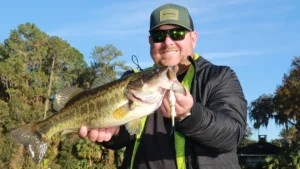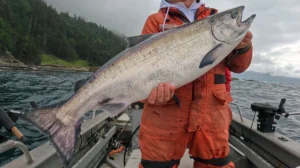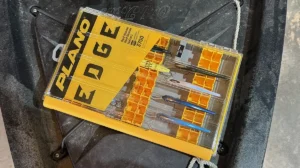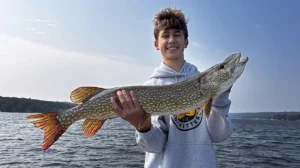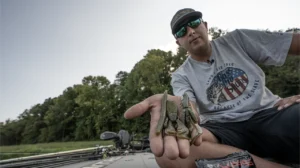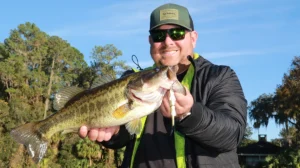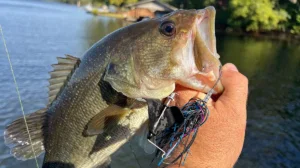John Crews is a deep thinker, but toward the end of the year, the Bassmaster Elite from Virginia can become extremely shallow minded. No worries, Crews isn’t becoming petty; rather, fall has him dialed in on trackable bass movement.
“In the fall, a lot of the baitfish go shallower — little short pockets, long pockets, ends of creeks — and fish follow them,” Crews notes. “A lot of times, in the fall, the fish are roaming and I feel crankbaits offer an excellent way to cover lot of water and intercept those fish.
“A crankbait is my primary fall bait. I’ve probably caught more fish in the fall on a crankbait than any other bait.”
Crews points out that “shallow” may include isolated cover, as well as flats, points, etc. In his experience, any fall pausing is a temporary thing. Nevertheless, crankbaits are equally enticing in search and targeting mode.
“Fish may roam and set up by cover to ambush, but I don’t think they sit there very long — it’s not like spring, where they’re territorial,” Crews said. “They’re just temporarily using that as a place to hang out and they’re just going to wander around a little more until they run into the baitfish again.”
For Crews, ideal fall cranking conditions are stained water with visibility of about 4 inches to 2 feet. Sky conditions don’t seem to limit the cranking bite; they simply reposition the game.
“I’ve had really good days when it’s sunny and I’ve had really good days when it’s cloudy,” Crews said. “In the sunny periods, it seems the baitfish go shallower and then in the cloudier conditions, the baitfish relate more to the edges of the flats or the deeper banks.”

Top targets
Here’s what attracts Crews’ attention.
Bridge pilings: To mimic the typically smaller size fall baitfish, Crews favors the SPRO Little John Micro DD. This modest profile bait runs 7-8 feet and emits a tight wobble that interests hungry fish.
“Anytime you’re cranking in the fall, you want to make as long a cast as possible and cover as much water as you can,” Crews said. “Also, keeping your retrieves slightly erratic – starting and stopping – is a key.
“I’ve seen times in the fall when canning fast triggers them. So you have to alternate between the two to see what triggers them.”
As for proximity, Crews offers the following advice.
“Hitting the piling is definitely a trigger, but in the fall, you don’t necessarily always have to hit the piling. A lot of times, you can be cranking near a piling and have an erratic retrieve and the next thing you know, it’s loaded up.”
Riprap: Noting that a small stretch of bridge riprap in the creek is easier to dissect than a mile-long causeway, Crews starts with a SPRO Baby Fat John 50, which runs 2 feet and stays in front of the shallower fish.
“A lot of times, those fish will be pointed right up on the bank, looking at the rocks,” he said. “If you throw out in four feet or more, you’re fishing behind the fish.”
For the less active fish sitting off the riprap, Crews switches to the Little John Micro DD. Banging this bait of those outer rocks tempts the fish laying off between feeds.
“There have been times I’ve fish shallow, then turned around with a deeper crankbait and caught fish behind (my original depth). Crews said. “I typically go for the aggressive ones first, but because those fish move in the fall, I’ll often catch fish off the same stretch of riprap at multiple times throughout the day.”
Flats with wood: “Flats are good in the fall because the baitfish come up from the deep water and get up on top of them to feed or to warm on the sun,” Crews said. “That cover is a stopping point for the fish to hide behind. Because the fish will be on the move with the baitfish, if I see a piece of isolated wood, I’m gong to hit it 4-5 times throughout the day and if I catch a fish – especially if it’s a good one – I’ll come back multiple times.”
For shallow flats, Crews throws the SPRO Fat John 50. If it’s a deeper spot, he goes with the SPRO Fat John 60, a slightly larger bait that’ll bang off the wood to trigger bites.
Docks: The Fat John also does a good job of tracing docks with a hunting action that probably looks a lot like a fleeing baitfish. While paralleling the face, running down the sides, probing corners and reaching into boat slips, Crews focuses on varying his retrieve.
“I’ll maintain a straight retrieve, but I’ll speed up and slow down within a cast,” he said. ”I’ll speed up three to four turns, slow it down, then speed up again. That gives them a little different vibration.”
Brush: Playing a role similar to wood on the flats, shallow brush offers a temporary feeding spot that Crews hits with the SPRO Fat John. Later in the fall, when the baitfish pull off the bank and hover around deeper brush, he likes a Little John Baby DD 60, which runs 10-12.
“Overall, the brush tends to be better when it’s sunny, but the presence of baitfish is most important,” Crews said.

Success in solitude
Another point Crews stresses: isolated cover is best. For one thing, the fall drawdown takes a lot of otherwise attractive cover out of play; but in particular, a laydown extending into decent depth all by its lonesome is money.
“I’ve had laydowns where I caught fish three or four times in the same day,” Crews said. “The fish come in and stop; if you’re there when they’re there, you catch them and then 30 minutes to an hour later, another fish comes by and parks on it.”
Crews’ rule for isolated cover: Make multiple casts from multiple angles. As he notes, fish may be positioned on different sections of the cover and, while they may not be watching every single cast, they’ll quickly focus their attention on the sound of a deflecting crankbait.
Sometimes, it takes a little bit to trigger the ones that are there,” he said. “But then there are times, when I feel there are fish within the vicinity and when you hit the crankbait against that tree, it’s going to draw fish toward that tree.
“If you make that same cast three or four times, that may trigger a bite. I’ve had it happen often in the fall when fish come up and after the fourth cast to the same piece of cover, you get a bite.”

Gear details
Crews throws all of his crankbaits on a 7-foot medium heavy Cashion Squarebill Rod with a 6.3:1 Daiwa Tatula reel. His line choice is 10- to 16-pound Sunline Crank FC because the XPlasma coating comes over cover better than other lines.
For fall cranking, Crews sticks to three styles of shad type colors – shiny (chrome), pale/translucent (cellmate) or bright (chartreuse). With any of these choices, he’ll often have silent and rattle versions handy.
“I’ve seen where rattles can make a huge difference,” Crews said. “That makes a bait stand out from hordes of fall baitfish.”


